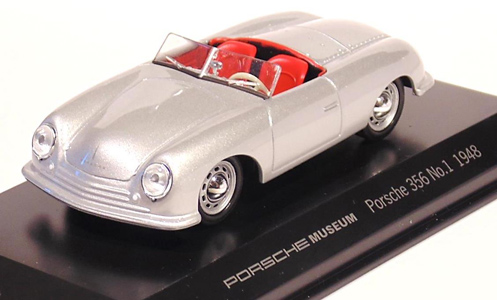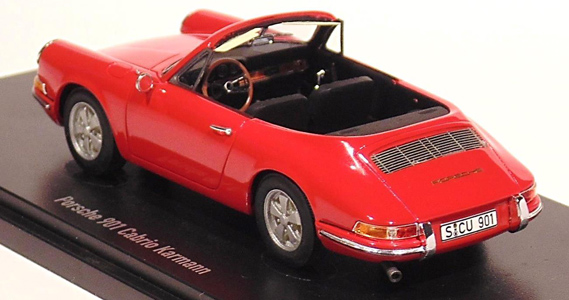The saga of the Porsche 911 viewed through the medium of model cars - Vintage of 1964
| Introduction |
| On June 8, 1948, the prototype 356 n°1, a roadster, became the very first Porsche in history to take to the road. It was officially unveiled in March 1949 at the Geneva Motor Show. |
 |
| Porsche 356 n°1 - Welly WAP0207900K |
| The Porsche 356 was produced in series with many modifications and in several variations until 1965. |
 |
| Porsche 356 - Quiralu |
| From the end of the 50s, Porsche prepared the renewal of the aging Porsche 356. The designer Erwin Komenda, creator of the VW Beetle and the 356, was in charge of the design of the bodywork. However, Ferry Porsche felt Komenda was "behind the times" with new trends and thus appointed his son Ferdinand Alexander (FA), fresh out of school, to head the department. After a tense period, the two men worked hand in hand to design the bodywork of the 901. The engine specified by Ferry Porsche, was a flat 6-cylinder, which was fine tuned by his nephew, Ferdinand Piëch (who was still at school but definitely hired in 1963) plus the engineer, Hanz Metzger. With this intention, more than ten prototypes were built and tested before the introduction of the Porsche 901. As we will see later, the convertible was planned from the very beginning. |
| Determining the model's vintage |
| In general, Porsche's model year or vintage coincided with the IAA in Frankfurt and therefore commenced in September. The cars launched and built from this time onwards were thus models of the following year. However, for marketing purposes, the model year could also be brought forward to July or August, which was what happened in the case of the first generations of the 911. Thus the model year had nothing to do with the calendar year or the date of first registration, it was the chassis number which was used to determine the vintage of the car. |
| Porsche 911 Classic |
| The Porsche 911 Classic, corresponding to the first generation of Porsche 911, were built at a rate of 111.995 vehicles (source: Porsche) from 1964 to 1973, that is to say from September 1963 through July 1973. They were split into two groups: the short SWB (for Short Wheelbase) chassis with a wheelbase of 2211 mm until 1968; and, thereafter, the long chassis LWB (for Long Wheelbase) with a wheelbase of 2268 mm, from vintages 1969 to 1971 and 2271 mm for the vintages 1972 and 1973. The prototypes had a wheelbase of 2204 mm. For the 1967 and 1968 models, Porsche remedied this problem by weighting the front bumper with cast iron blocks, in order to increase the weight on the front axle. It was only after the model year 1969 with the lengthening of the wheelbase by 57 mm, that the problem would be conclusively resolved. We will see hereafter that each vintage of the Porsche 911 Classic included some features that made them recognizable. as long as they retained or have been restored into their original configuration, which unfortunately is not always the case. |
| Vintage of 1964 |
| SEPTEMBER 1963 : On September 12, 1963 the 901/5 prototype was exhibited at the IAA in Frankfurt. It was champagne yellow color and was fitted with a dummy engine, because the engine was not yet ready. It was not until February 1964 that the prototype was kitted out with one of the first Flat 6 engines type 901 and displayed at the Paris, London, Turin and Geneva motor shows. This engine had two separate exhaust outlets, positioned between the two bumpers. The standard 901s would have only one exhaust outlet positioned on the left. |
 |
| Prototype 901 n°5 - Spark S4463 |
| JUNE 1964 : In June 1964, the 901 prototype, chassis n°13360, was dispatched to Karmann body shop to cut out the roof and reinforce the chassis. Returning to Porsche at the beginning of September, the 901 prototype cabriolet was subjected to extensive testing. Unfortunately, a series of problems arose, and, lacking time to address them and enter into production, the engineers modified a 901 coupe by adopting a flexible rear window and a removable roof panel. Thereby the Targa was born, and it was launched in September 1965 at the Frankfurt Motor Show. |
 |
| The 901 Karmann convertible prototype was sold by Porsche to the German driver Manfred Freisinger in the latter half of the sixties. The vehicle had no engine, no gearbox, no wheels, no tires and no front seats. Once Freisinger acquired the car, he equipped it with an original engine and front seats. Beneath the front hood, a first generation Fuchs rim, certainly experimental, had been left behind, as a spare wheel. Prompted by that, Freisinger decided to install Fuchs rims on the car. |
 |
| Prototype 901 Cabriolet Karmann - Autocult 90074 |
| The car was sold for the first time in 2001 to a collector from Ohio who had the Solex carburettor engine restored, and then, a second time in 2014, to a British buyer. In 2013, as part of the 50 years history of 911, it made a remarkable appearance on the Porsche stand at the Pebble Beach Concours d'Elegance. |
| Summary of the range of the 1964 vintage | |||||
| Prototype 901/5 | Coupé | 2.0 L | 130 Ch | 9,1 s | 210 Km/h |
Exterior details : - Chrome windshield wipers angled to the right when stopped. - Painted front and rear bumpers with aluminum molding and black rubber trim. The rear bumpers are fully chromed. - Front fenders without bumpers. - No fog lights, nor a dedicated place for them. - Round, slightly tapered chrome exterior mirrors. - Chrome horn grills. - No lower body trim. - Rear hood with chromed air vent. - Gold "PORSCHE" lettering on the rear hood, smaller than on the standard models (no inscription of the model). - 15" sheet metal wheels with flat chrome hubcap, decorated with circular Porsche badge. Interior details : - The interior finish of the prototypes was close to that of the 356, it was only in 1965 with the production of the 901, that the interior fittings would be specific to the model. |
|
|




































































































































































































































































